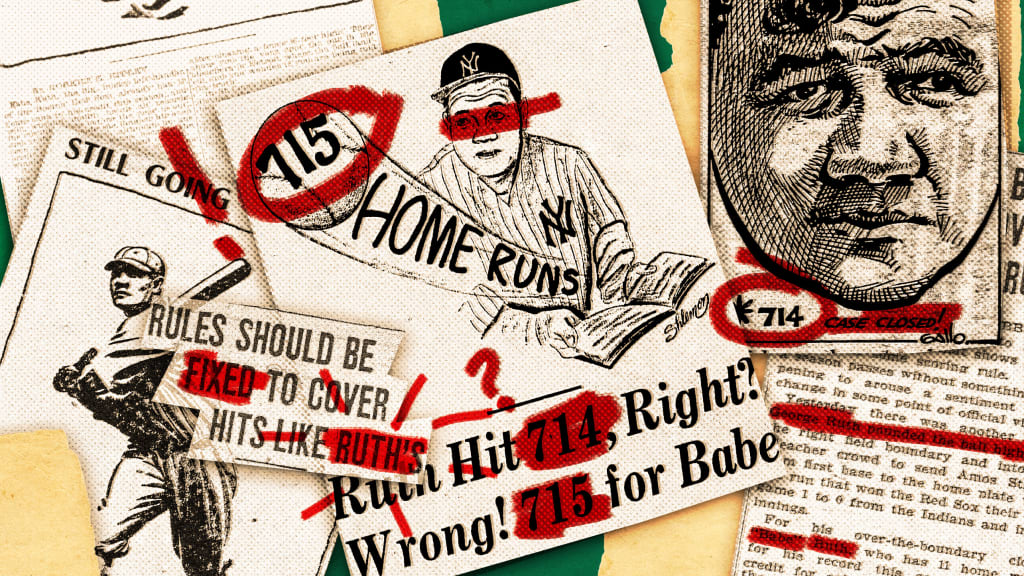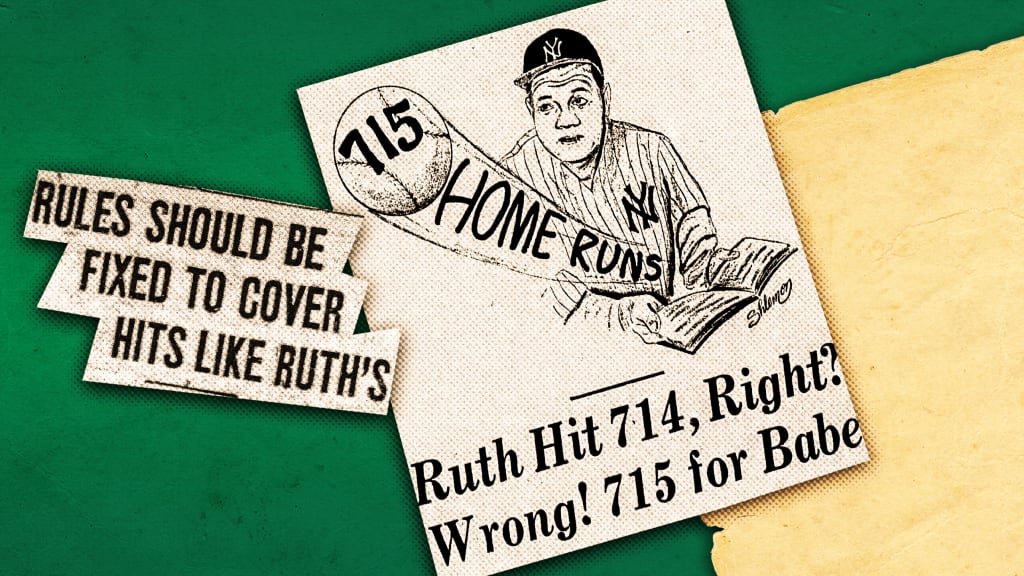
A version of this story was originally published in December 2021.
Babe Ruth's 714 home runs are one of those baseball numbers that become ingrained in the minds of so many who follow the game. Even after Henry Aaron passed him with No. 715, the Babe’s total carried some weight. He still held the record for home runs by a left-handed batter for another 32 years, until Barry Bonds eclipsed him. Even now, just four players have clubbed more than 700 homers in AL/NL history, with Albert Pujols joining them in 2022.
But what if George Herman Ruth actually hit 715 round-trippers? Well then, Aaron’s record-breaking clout would’ve come on April 11, 1974, three days later than his 715th, and it would’ve been a different Dodgers pitcher who served up history. Instead of Al Downing, the answer to the trivia question would be Charlie Hough. Rather than a game-tying two-run homer in the fourth inning, Aaron’s record-breaking shot would’ve been a go-ahead solo shot in the seventh.
That would’ve been the case had the initial ruling of MLB’s Special Baseball Records Committee in April 1969 stood. But after initially giving Ruth credit for his overlooked 715th home run, the committee reversed itself, and the record remained at 714. Here’s what happened.
*****
When is a home run not a home run? When it's 1918 and the rules say so.
Before 1920 -- before there was a Commissioner of Baseball and the various leagues played under their own rules -- games that ended with the home team winning in the ninth inning or later (what we now call walk-off wins) were over as soon as the decisive run crossed the plate. So if there was a runner on first base in a tie game in the bottom of the 11th and the batter hit the ball out of the park, the game ended as soon as that runner crossed the plate, leaving the batter on third with a triple.
This scenario played out in the bottom of the 10th at Fenway Park on July 8, 1918. With the score 0-0, a 23-year-old Ruth stepped to the plate with Amos Strunk on first base. The Babe was in the midst of his transition year from being a pitcher who hit to a hitter who once pitched. Here are his innings pitched and plate appearance totals from his age-21 to age-24 seasons in Boston:
1916: 323 2/3 IP; 152 PA
1917: 326 1/3 IP; 142 PA
1918: 166 1/3 IP; 382 PA
1919: 133 1/3 IP; 543 PA
Stan Coveleski, also a future Hall of Famer, was on the mound for Cleveland, and Ruth clobbered a pitch over the right-field wall – reported to be the longest home run in the ballpark’s brief history to that point, three-quarters of the way up the bleachers. But because the rules of the day said the game was over once Strunk crossed the plate, Ruth only got credit for a triple.
Even then, observers saw the flaw in the rule. “RULES SHOULD BE FIXED TO COVER HITS LIKE RUTH’S,” read a headline in the Boston Globe the next day. “There is no reason why the circumstance of having a man on base when Ruth made what ordinarily would have been a home run, should be turned to the disadvantage of the batter,” Melville E. Webb Jr. wrote. “It is not a question of the ball game being won the moment the first runner touches the plate -- every one knows that this is now the rule. But what harm would it be for the rulemakers to shift the scoring rules so that such a hit as Ruth’s would be officially recorded?”

Those scoring rules would change less than two years later but wouldn’t be retroactively applied. That would come in 1968, when Commissioner William Eckert convened the SBRC to standardize MLB’s statistics and records for the publication of the first Baseball Encyclopedia. That committee was the one that determined which leagues were to be known as Major Leagues, leaving out the National Association of 1871-75 and, more notably today, the Negro Leagues (which weren’t even considered).
But the committee also decided to retroactively apply the rules as they were in the late ’60s to all of baseball history back to the founding of the National League. Specifically: “Major league baseball shall have one set of records, starting in 1876, without any arbitrary division into nineteenth- and twentieth-century data.”
In the course of its research, the committee found 37 instances when a batter on the home team hit what today -- and in 1968 -- would be considered a walk-off home run but was only credited with a single, double or triple. It was announced in April 1969 that when The Baseball Encyclopedia was published later that year, those 37 hits would be recorded as home runs.
Headlines at the time, naturally, focused on Ruth:
“Ruth Hit 714, Right? Wrong! 715 for Babe” – Chicago Tribune
“Babe Ruth Belts 715th Home Run” – Tampa Bay Times
“Ruth’s 714 homers finally topped” – Arizona Republic
“Sorry About That, Willie: Babe Just Hit Another” – Wisconsin State Journal
“51 Years Later, the Sultan Has Another Swat” – Minneapolis Star Tribune
But there was pushback. Columnist Dick Young wrote in the New York Daily News, “I mean, somebody decided that Babe Ruth hit one in 1918 that was called a triple and should have been called a home run. That’s 51 years ago, and while 51 years is not too long ago to correct a mistake or an oversight, this was not a mistake or oversight, this was the simple and proper application of the rule as written at the time.”
Not two weeks after the news broke, the committee met again and decided, by a poll of its members, that it wouldn’t apply current rules to earlier years.
“The mission of the computer people as authorized by baseball’s special records committee, was to research all data, correct obvious errors, uncover missing material and clear up gray areas,” Joe Reichler, a member of the committee, was quoted as saying. “Upon reflection it was felt that the committee had gone beyond its authority in the interpretation of its instructions.”
And so Ruth’s total remained at 714. In fact, he might’ve come out ahead. As Young pointed out in his column, commending the committee for its reversal, “I say this in behalf of Babe Ruth, because I am sure he doesn’t want two homers taken away from him -- the two he hit that bounced into the stands and which, under the rules of their day, were home runs, but would be doubles today.”
Yeah, 713 home runs just doesn’t have quite the same ring to it.
